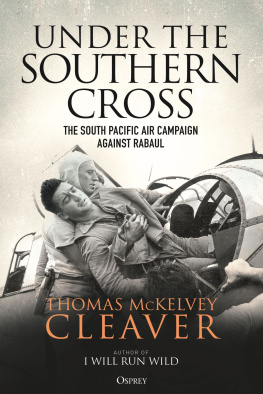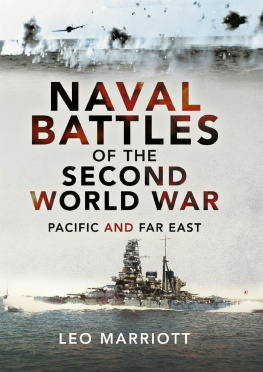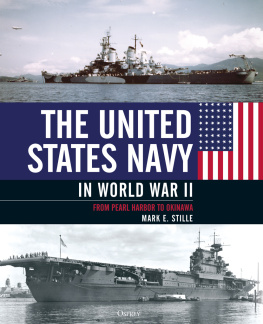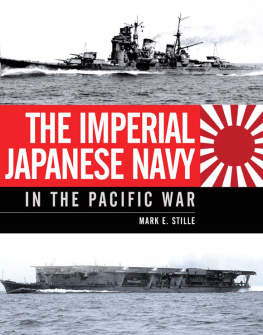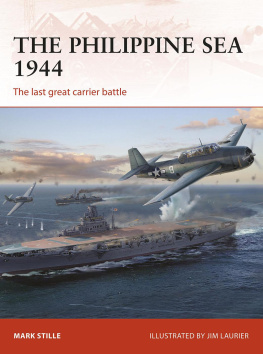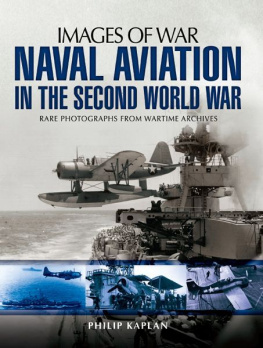Coral Sea 1942
Turning The Tide
Richard Freeman
Richard Freeman 2013
Richard Freeman has asserted his rights under the Copyright, Design and Patents Act, 1988, to be identified as the author of this work.
First published 2013 by Endeavour Press Ltd.
This edition published 2019 by Endeavour Media Ltd.
Table of Contents
1.Retreat and defeat
The Japanese success in their surprise attack on Pearl Harbor on 7 December 1941 proved to be the prelude to six months of humiliating defeats for the allied forces in the Far East. Never had the Americans experienced so much failure in so little time.
Within 24 hours of the Hawaii attack America was at war and Japanese planes were pounding her huge airbase at Clark Field in the Philippines. General Douglas MacArthurs commanders proved to be as ill-prepared as their Hawaiian counterparts. In minutes almost all the American heavy bombers had been destroyed by bombers of the unopposed Japanese 11th Air Fleet. A second attack by Japanese Zeros strafed the base, causing further costly damage. A simultaneous assault at Iba Field was at least detected by radar and Curtiss P-40 Warhawks were sent to intercept the incoming planes. Even so, the attack left just two useable P-40s on the base. By the time the Japanese departed half of the American Far East Air Force had been destroyed.
Two days later the American naval base at Cavite in Manila Bay was severely damaged by a Japanese air attack. By early January it was in enemy hands. That same day two British battleships, the Prince of Wales and Repulse, were sunk by Japanese air power off the coast of Malaya. These attacks were rapidly followed by American surrenders at Wake and Guam.
The first significant step that the Americans took to arrest the Japanese advance was to recall the carrier Yorktown from the Atlantic Ocean. On 21 December she passed through the Panama Canal into the Pacific. Under Rear Admiral Frank Fletcher she was to play a heroic part in halting the Japanese advance.
Meanwhile the relentless Japanese military juggernaut rolled on. On 24 December the Americans more or less abandoned the Philippine waters as Admiral Thomas Hart, Commander-in-Chief, Asiatic Fleet, withdrew most of the his ships.
For the moment the American Pacific Fleet was only capable of what Captain Frederick Sherman was to call retreat and defeat. Full frontal attack was out of the question. Admiral Chester Nimitz, Commander in Chief, United States Pacific Fleet, was forced to limit his retaliations to minor raids on places such as the Marshall Islands (February), Wake Island (February) and Marcus Island (March). These raids were mostly morale raising exercises but they also bought time for the Pacific Fleet to recover from Pearl Harbor and gave the sailors and airmen a chance to hone their battle skills.
However the strategic position worsened by the day. The loss of the carrier Langley on 27 February and President Roosevelts order to MacArthur to leave the Philippines on 11 March told the real story. So did the sinkings. On top of the losses at Pearl Harbor, the allies had lost thirty-four ships, including one carrier, two battleships, five cruisers and 14 destroyers. No allied ship was safe if it came within range of Japanese air attack. The arrival of a Japanese carrier force brought death and annihilation. Wherever they had been Pearl Harbor, Celebes, Darwin, Java, Colombo they had obliterated the forces that dared to oppose them.
The advance of the Japanese continued when, in March, they sent an invasion force to the Salamaua-Lae area of New Guinea. The American carriers Lexington and Yorktown were dispatched to the scene. Total surprise enabled them to sink or damage two thirds of the enemy transport ships for the loss of only one Dauntless dive-bomber. But the Japanese still held the two ports. Elsewhere the Japanese took the Bataan Peninsular (9 April) and Corregidor (6 May) in the Philippines. More embarrassingly, General Joseph Stilwell was forced out of Burma with, he said, a terrible licking.
The plain fact was that the American Navy was, in the words of Admiral Sherman, serenely unprepared to face their audacious enemy. So paralysed were the American commanders that they sent their ships to sea merely to avoid attack in harbor. If America was to win the Pacific war, something had to happen. That something was the Battle of the Coral Sea.
2.Next stop Port Moresby
Admiral Nimitzs raids had an unexpected consequence. Admiral Isoroku Yamamoto, Commander-in-Chief of the Japanese Combined Fleet, was staggered by the skill and daring of the American forces. He had planned the attack on Pearl Harbor in the belief that the Americans were weak and lacking in resolve. Now shaken out of his pre-war assumptions he realised that the American carriers imperiled his plans. They had to be wiped out.
Yamamotos top priority was to take the Midway Atoll an important American air base and anchorage, strategically placed in the middle of the vast ocean. But first he needed to secure the southern limits of what the Japanese called their outer defence perimeter. Until that was done there was too high a risk of attack from the south by the western allies. And so was born operation MO.
Yamamoto needed control of the Coral Sea, both to eliminate an allied naval presence there and to bring Australia within bombing range of land-based Japanese planes. This sea, surrounded by Australia, New Guinea and the Solomon Islands provided a vital route connecting Australia to the west coast of America. Yamamotos plan was to gain control of this sea by first taking the small island of Tulagi in the Solomon Islands and then taking Port Moresby in New Guinea. Tulagi would become a seaplane base to keep watch on the American Pacific Fleet, while Port Moresby would provide a platform for mounting bombing raids on Australia.
Japans choice of Port Moresby was astute. Before the outbreak of the Pacific war the Australians had already recognised its strategic importance. Whoever occupied the site was able to control the passage of ships and planes to and from Rabaul a key Japanese base on the island of New Britain and of east-west traffic between Australia and America. The Australians were currently in possession of the port and were busy establishing an amphibious operations base, with a dock, airfield and workshops. It was a tempting prize for the Japanese.
Amphibious landings are notoriously difficult to pull off, although the Japanese had an impressive record of victories behind them since the start of the war. But this time there would be a difference: the Americans had foreknowledge of the plan.
Unknown to Yamamoto, the Americans had access to the Japanese naval code and in March 1942 they had decoded signals referring to an operation MO. In early April the signals began to contain specific orders to send carriers to the Coral Sea and, by 27 April, Nimitz knew that the target was to be Port Moresby. (There was an associated operation, RY, to invade Nauru and the Ocean Islands, but we shall not pursue that here.)
The base for the attack was to be Rabaul in East New Britain, to the north of the Coral Sea. Destroyed by volcanic ash in 1994, Rabaul was only a small town, but the Japanese had turned it into a fortress. At its peak in 1943 it held 110,000 troops, protected from air attacks by miles and miles of bomb-proof tunnels. It was here that vessel after vessel started to arrive towards the end of April. These included carriers, two or three battleships, three heavy cruisers, two light cruisers, 16 destroyers, a submarine tender and six submarines. There was also a huge build up of forces at the Truk Lagoon further to the north. It was clear to Nimitz that very serious trouble was brewing.
By early May all was set for the Japanese invasion of Port Moresby on 10 May. The headquarters of the Japanese Fourth Fleet under Admiral Shigeyoshi Inoue had been moved south over 1000 miles from the Truk Lagoon to Rabaul. Meanwhile carriers had been bringing planes to Rabaul ready for the MO attacks.
Next page

